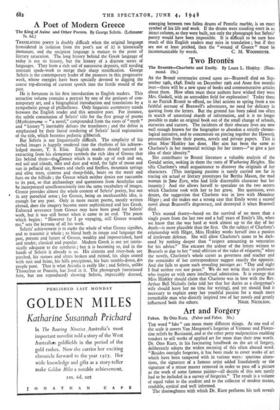Art and Forgery
THE word " fake " can mean many different things. At one end of the scale it covers Van Meegeren's forgeries of Vermeer and Floren- tine reliefs by Bastianini' and at the other petty malpractices enabling vendors to sell works of applied art for more than their true worth. Dr. Otto Kurz, in his fascinating handbook on the art of forgery, deliberately adopts the widest meaning of this often abused word. "Besides outright forgeries, it has been made to cover works of art which have been tampered with in various ways : spurious altera- tions, the signature of a famous artist added fraudulently or the signature of a minor master removed in order to pass off a picture as the work of some famous painter—all deceits of this sort surely had to be included in a survey of forgeries." The result is a volume of equal value to the student and to the collector of modest means, readable cynical and well informed.
The readable, with which Dr. Kurz performs his task reveals how great are the. gaps in the recorded history of forgery. We know almost nothing of the forging of Italian primitives before the last quarter of the nineteenth century, yet the practice of forgery was coterminous with the taste for primitives. The National Gallery, for example, contains a forged panel by Matteo di Giovanni with a pedigree going back to 1854, and, unlike the better-known Matteo di Giovanni forgeries made later in the century by the notorious Ioni, this panel has secured admission to all lists of the artist's work. Some great masters clearly lend themselves more readily than others to imitation ; an especially imitable artist is Botticelli, whose works have been forged in some numbers in a reasonably convincing way. In theory the progress of scientific aids should make these forgeries easy to detect. But in practice in these matters science is no sub- stitute for common sense. The case of Renaissance sculpture is rather different, for here the objective criteria to be applied are less precise. When certain categories of forgery have been ruled out, the main danger in this field is of undue exclusiveness, and the tendency has been for students of Italian sculpture light-heartedly to dismiss as forgeries the works they were unable, to explain. This defensive reflex is illustrated in the standard Storia dell'Arte Italiana of Adolfo Venturi, who managed to convince himself that fifteenth-century Italian sculpture ceased to be authentic the moment it left Italy.
The selection of the plates is the least satisfactory feature of this interesting book. It would surely have been wise throughout to juxtapose original and forgery, and this should have been possible had Dr. Kurz made up his mind to omit certain works which are not, strictly speaking, fakes at all. In the last resort a fake is an object made to deceive. Paintings, drawings and sculpture do not become fakes because they are exhibited or sold as something other than they are, and while figures like the sixteenth-century warrior at Klagenfurt, which was supposed for some time after its discovery to be of Roman origin and is reproduced by Dr. Kurz on that account, might be included in a history of human gullibility, in a survey of



































 Previous page
Previous page